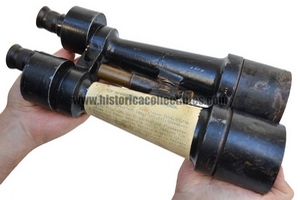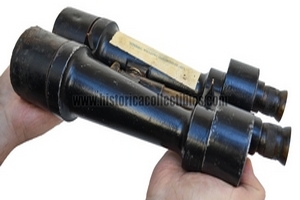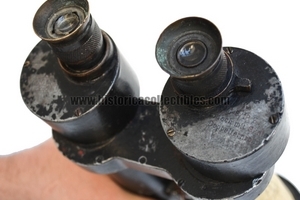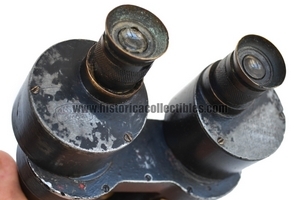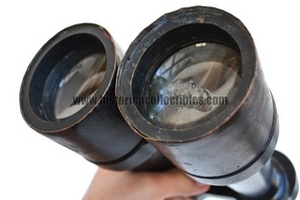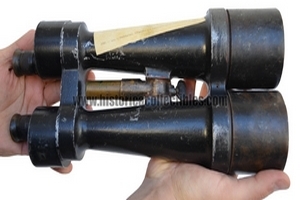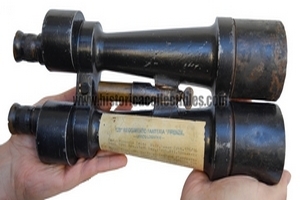Doppelfernrohr 15x Zeiss Karoly Györ, Major General Enrico Bolzano Von Kronstadt, 1918
Doppelfernrohr 15x60 produced by Zeiss Karoly in the Györ factory, found and recovered by soldier Angelo Ferrazza, Ardito of the XXVII Assault Battalion in June 1918, in the locality of Bavaria (Montello) Qt. 110 m., in the advanced observatory of Major General (Divisional General) Enrico Bolzano Von Kronstadt commander-in-chief of the 13th Schutzen Division (25th Brigade) and of all the assault regiments, such as 1, 14, 24, and 25, present on Montello in the second battle of the Piave or better known as the battle of the solstice, which was the last and desperate offensive launched by the Austro-Hungarians during the First World War.
The binoculars remained preserved for many years in the stores of the 128th Florence Infantry Regiment which ensured that the memory of them were not lost, by applying an official cartouche to them on which it was reported, in addition to the internal classification suitable for archiving and deposit, also the provenance for the facts for which it was acquired as a historical relic.
This binoculars, given to me personally in 2008 by an Army Officer, come from the decommissioned warehouses of the 78th Tuscan Lupi Infantry in Florence (Italy). The reason why this binoculars was found in the depot of the 78th Lupi di Toscana is unknown.
What can be stated with certainty is the reason why this binoculars, although recovered from an Ardito of the XXVII Assault Battalion, was taken over and cataloged by the 128th Florence Infantry. In fact, unlike the 128th Rgt. Florence Infantry (also a co-belligerent in that battle), the XXVII Assault Battalion was called to continue the advance aimed at reclaiming those territories still partly occupied by the retreating Austro-Hungarians. Certainly, a written report was made of this handover because although the archiving tag on the binoculars was affixed in 1919 (as can still be read from the polygraphic print), there are specific and detailed data on how and where the discovery and recovery of this binoculars occurred.
Thanks to the help of those who wanted to help me and allow me to access original period documents relating to those events, I was able to reconstruct, in their entirety, the events that occurred on that day, which led to the "capture" and death of General Enrico Bolzano von Kronstadt.
On 17 June 1918, some Arditi of the XXVII Assault Battalion continued to maintain their presence in the area between the Costone della Madonnetta - Sorgente del Forame, to the North-West of the Church of Giavera and the Busa delle Rane, to the North-East of the Church of Bavaria, in a stretch of line extending for approximately 1 km.
Their task was to "clear" the area from the infiltrations of the vanguard of Austro-Hungarian assault troops.
Their way of operating was characterized by acting in small groups, mainly using hand grenades and daggers in violent melee with the enemies, given that even the Austro-Hungarians could not have sufficient supplies of ammunition, given the difficulty of making arrive supplies from beyond the Piave.
On June 17, the impetus of the Arditi, in going out to face the enemy in the area north of the Church of Bavaria, allowed the capture of Major General Enrico Bolzano von Kronstadt, accomplished after wounding him, despite the presence of the escort, which was held occupied by another of our patrols.
The official report was briefly drawn up according to the reports received immediately from the witnesses and in particular from Lieutenant Marco Bergna of Como, Commander of the 1st Company, who declared that he had personally hit the General with a musket shot, also accepting that other soldiers , had hit him at the same time.
Major Freguglia, Commander of the XXVII Assault Battalion, also stated that the General was captured by the Arditi couple Angelo Ferrazza of Rome and Enrico Bonanno of Naples.
To this day, what Major Freguglia stated is confirmed in the short report, which led the 128th Florence Infantry Regiment to write that this binoculars was found by the Ardito Angelo Ferrazza.
The rank and position of General Von Kronstadt later turned out to be higher than those deduced from simply reading the identification plate on the person of the General, who was now dying.
The General declared his rank, after being treated by the casualty carriers, while he was transported to the Battalion's dressing station, but expired before reaching it.
The binoculars is in the same condition in which it was found in the location, as it was most likely subjected to bombing, in fact the binoculars show some trauma resulting from explosions that occurred a short distance away.
Furthermore, these binoculars are also covered on these 2 following websites dedicated to General Enrico Bolzano Von Kronstadt:
Exceptional historical artefact relating to the First World War.
Carl Zeiss takes its name from its founder, Carl Zeiss, who on November 17, 1846 chose the small town of Jena, in Thuringia, as the location for his precision optical equipment factory. Thanks to the severe quality control that Carl Zeiss imposed on his products, going so far as to personally destroy the microscopes that did not pass the tests, the newly formed Zeiss became the official supplier of the University of Jena and received the gold medal of the industrial exhibition in 1861 of Thuringia as the best research instrument produced in Germany, awarded to the Stand I microscope of 1857.
In 1866 the thousandth microscope was produced and the name Zeiss became known throughout European scientific circles. Thanks to studies on the Porro prism, in 1893 Abbe patented double prism binoculars, which accentuated the perception of depth.
The mass production of Zeiss binoculars began in 1894, already at the beginning of the twentieth century more than 30,000 were made, at the beginning of the First World War the quota had risen to 500,000 and, at the end of the Second World War, as many as 2,260,000 were produced binoculars for the civil and military market.
Models were made starting from 4x11 mm to 12x40 mm, up to real giants such as the 80 mm and 100 mm. Thanks to studies conducted on the perception of light in low light situations, it was demonstrated that the average dilation of the pupil in an adult is approximately 7 mm.
For this reason, the 7x50 mm model was introduced in 1910 and remained on the market until 1917 with few changes to the materials used. In 1926, following the post-war crisis of the First World War with the Treaty of Versailles which bankrupted many important German companies, Zeiss purchased "C.P. GOERZ" and founded Zeiss Ikon in 1926.
In 1937 Zeiss had commercial contacts and factories in more than 29 countries around the world. From '33 Zeiss acquired interest from the Nazi regime, which balanced production towards military instruments. It successfully produced binoculars with wide-angle optics for military use, pressure-resistant optical systems for U-boats, periscope binoculars for targeting tanks. Furthermore, Zeiss cameras were mounted on the V2s for remote sensing operations of the English coasts.
On 1 November 1935, Zeiss, in the figure of Alexander Smakula, patented a process for the treatment of optical glass with extraordinary results in terms of light transmission. Remained a military secret until 1939, it was adopted on binoculars to reduce ghost images and internal reflections.
During the Second World War, there were numerous bombings against the Zeiss factories. Jena was bombed several times by the Allies starting in 1944. Stuttgart was razed to the ground, although the Contessa-Nettel factory suffered little damage. The bombing of Dresden, in addition to devastating the city, also caused considerable damage to the Zeiss Ikon headquarters.
On April 13, 1945, American military forces entered Jena, surprising themselves that the bombing had not caused any significant damage. The main planetarium was in ruins, while the factories remained operational.

